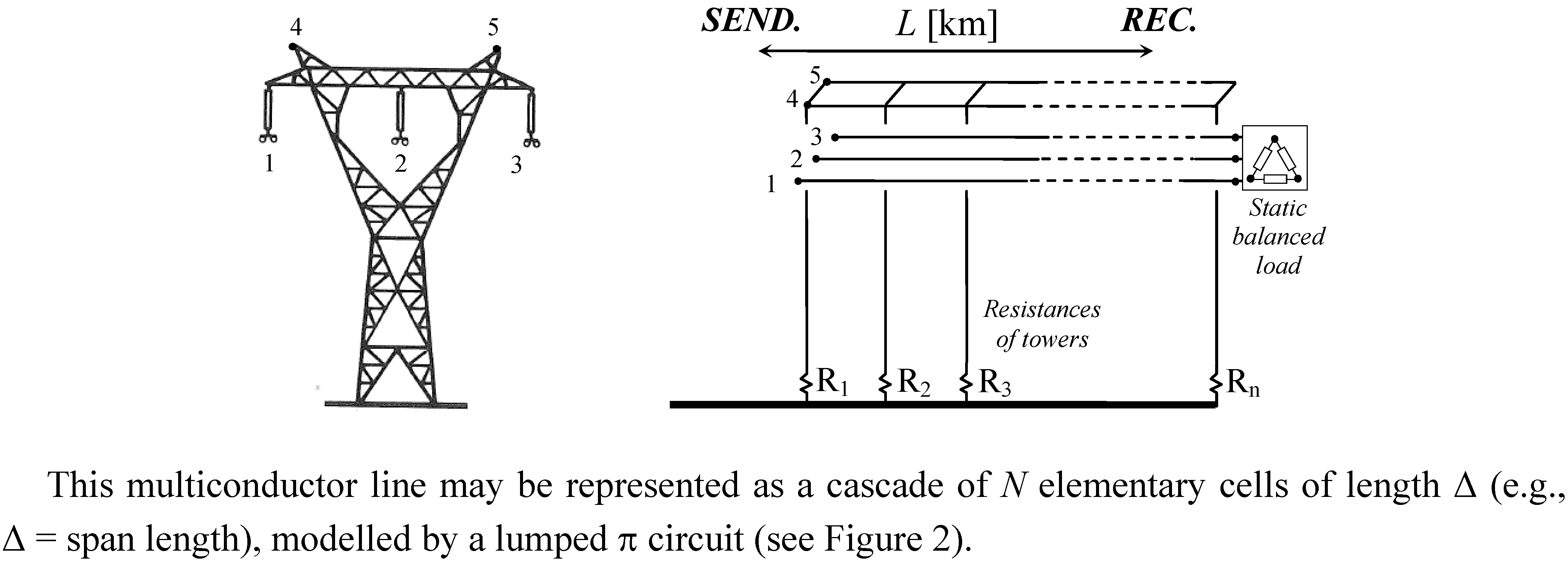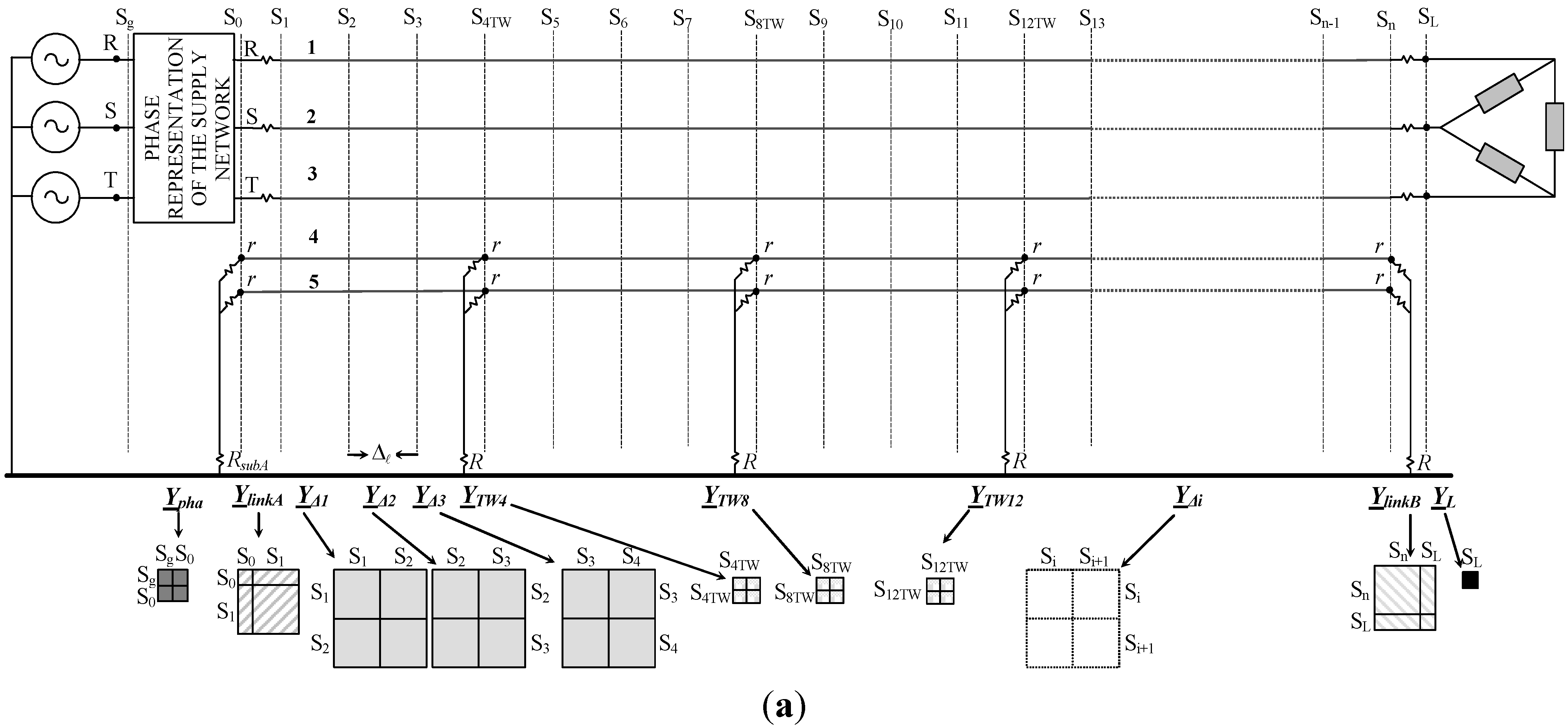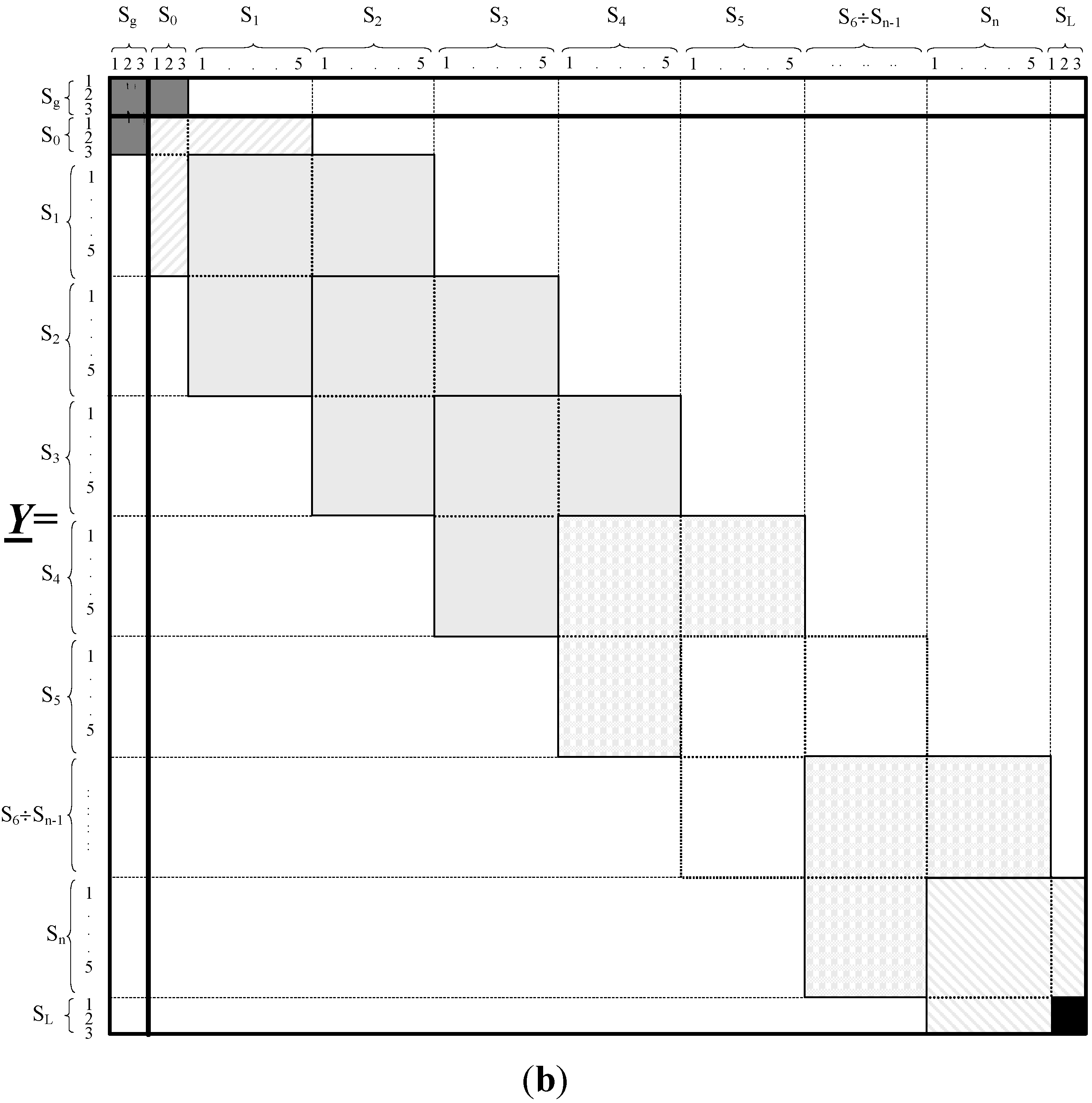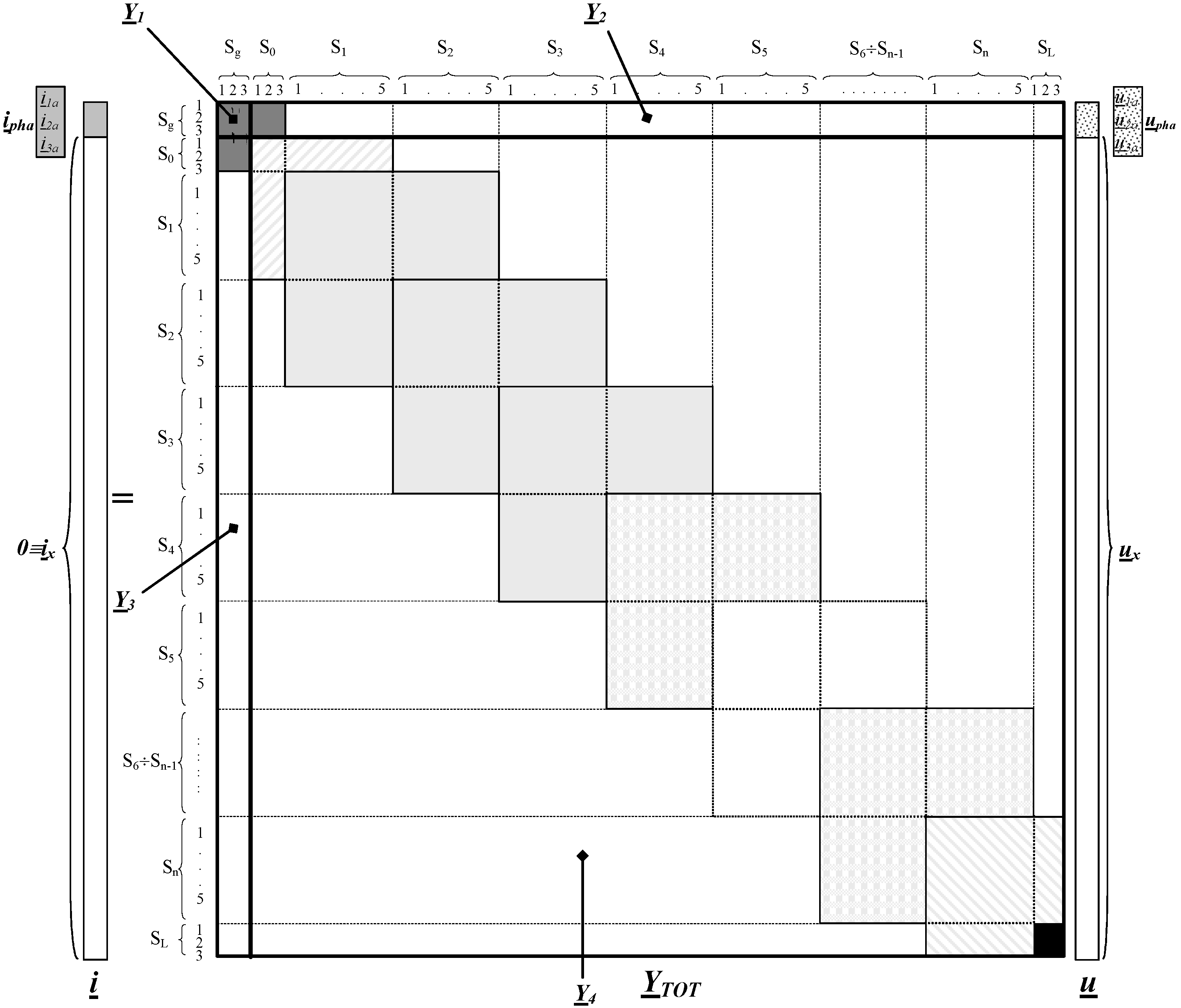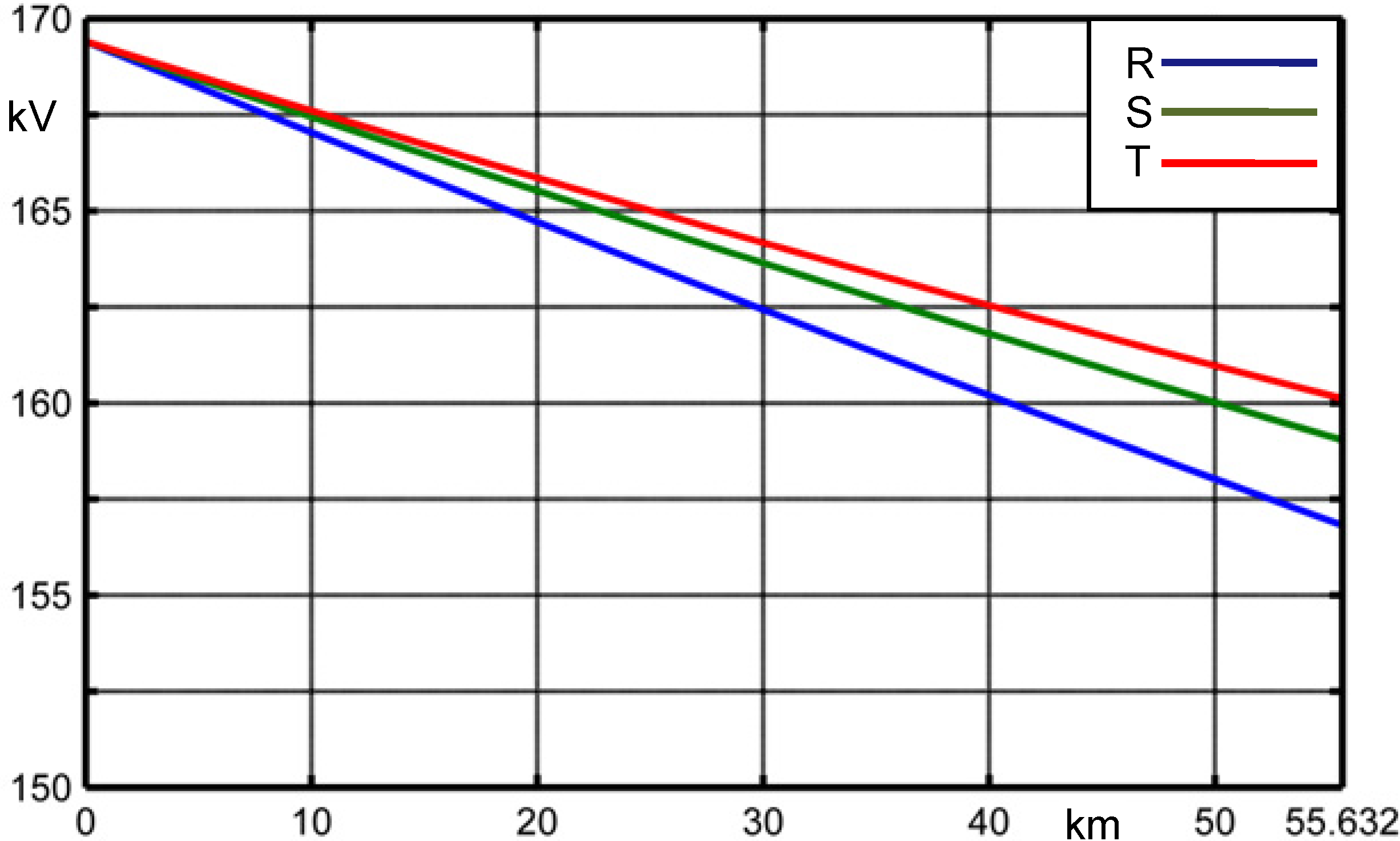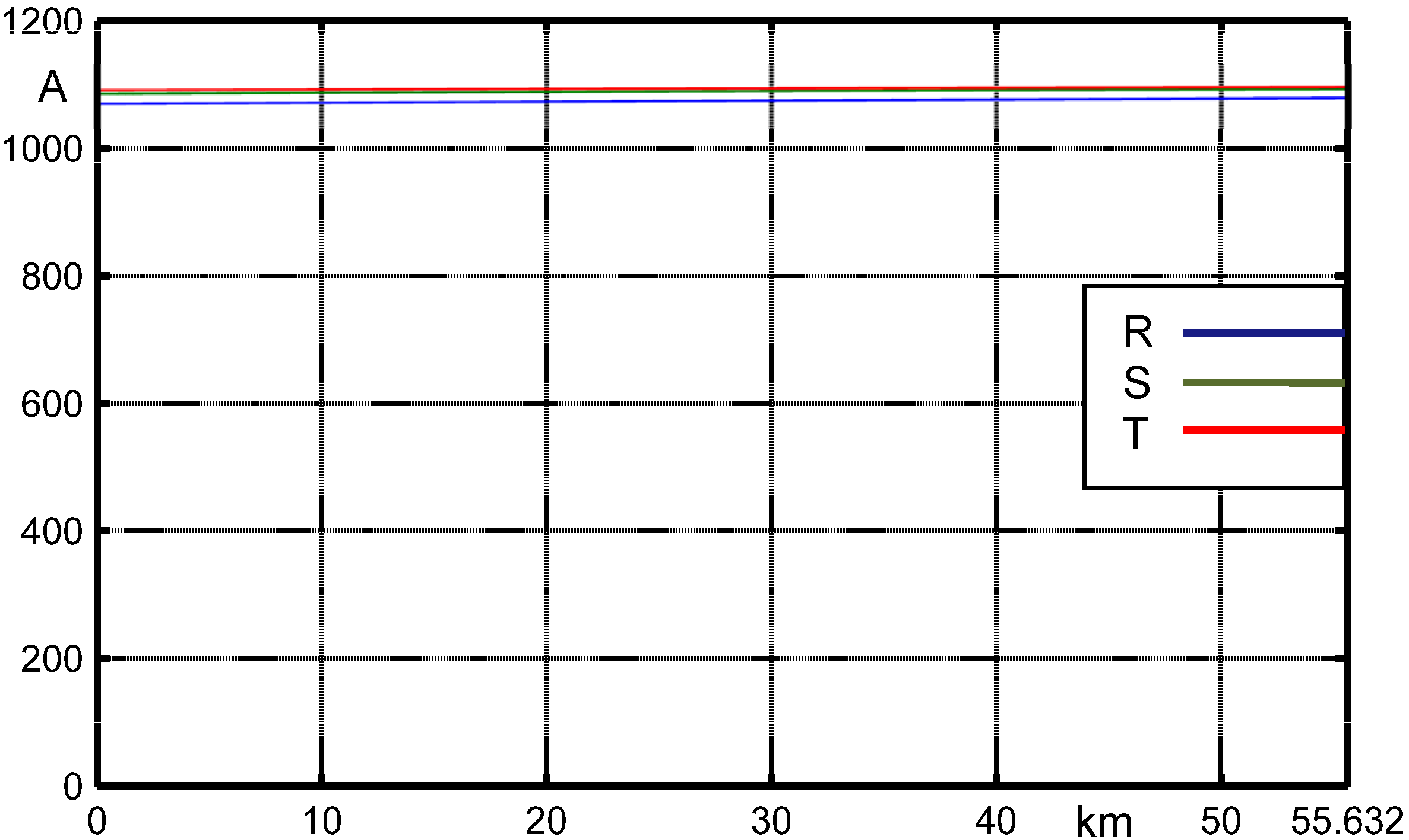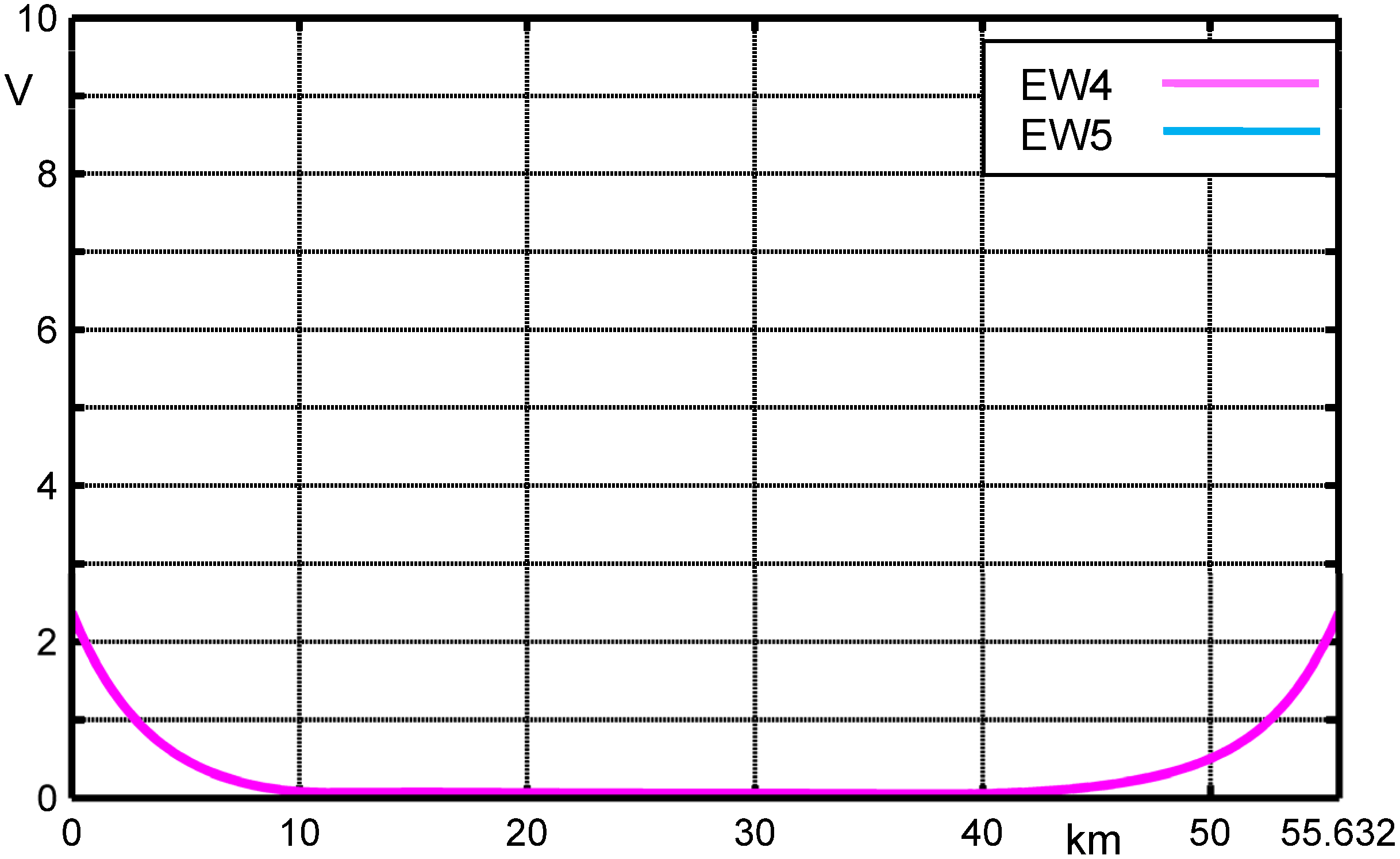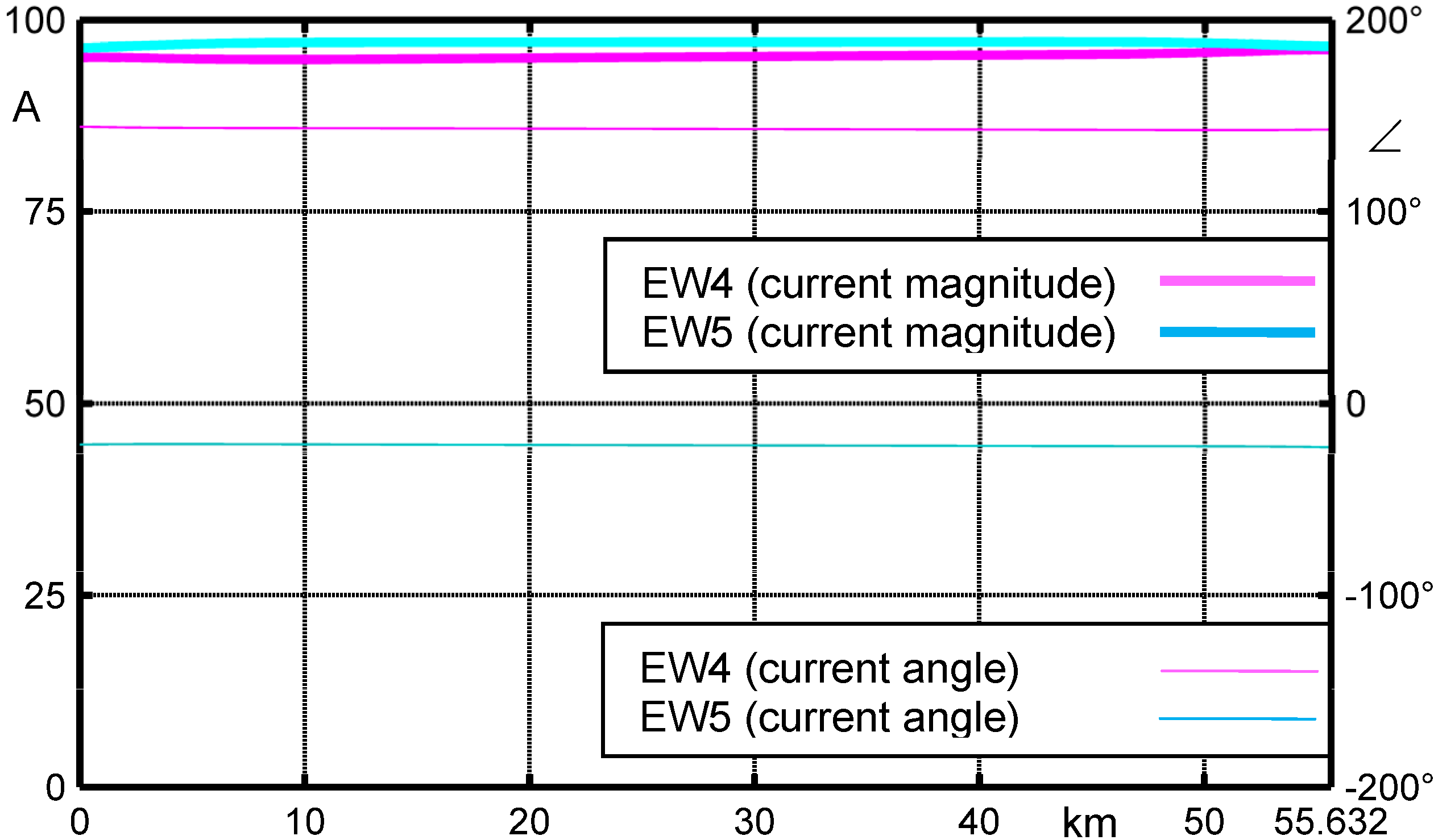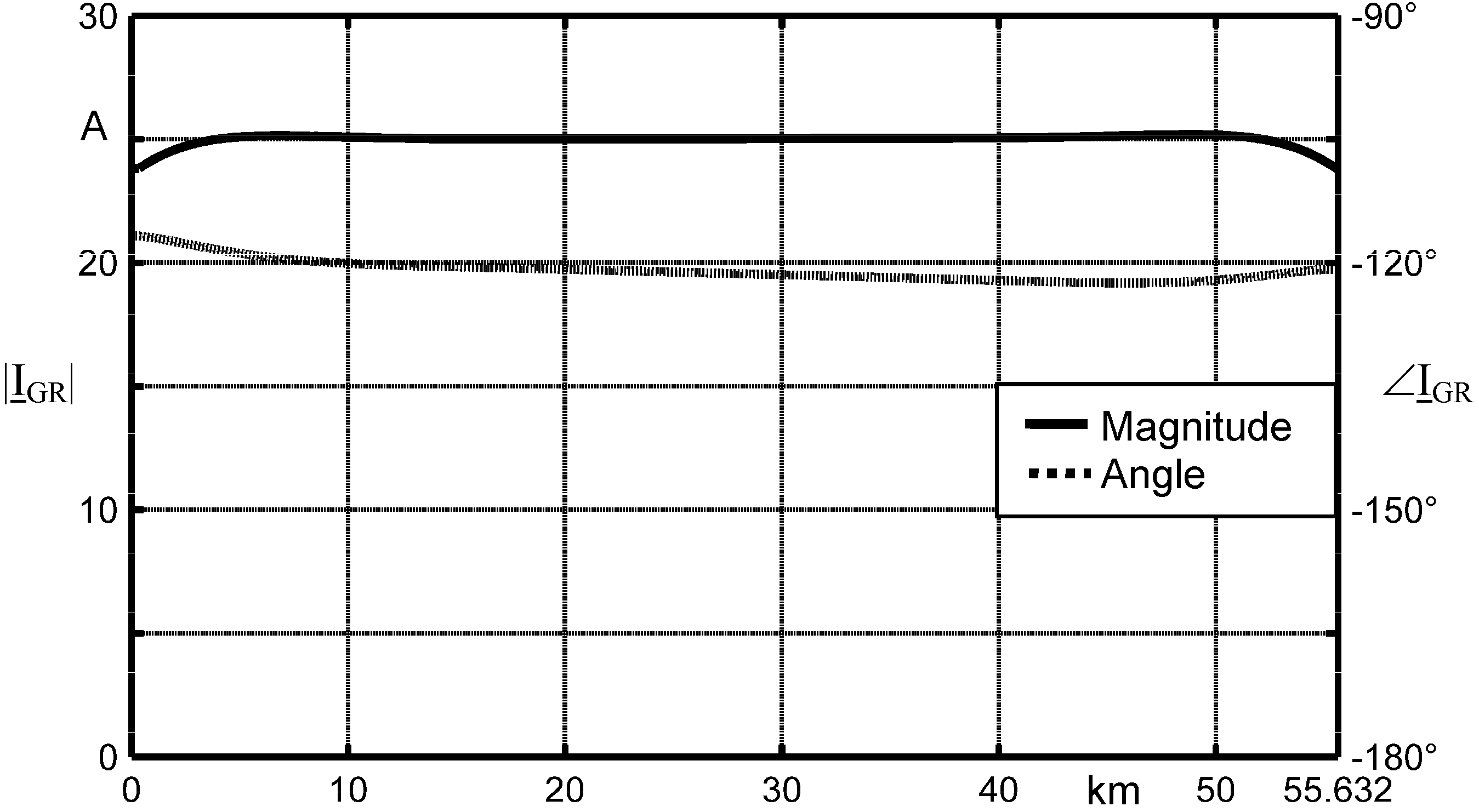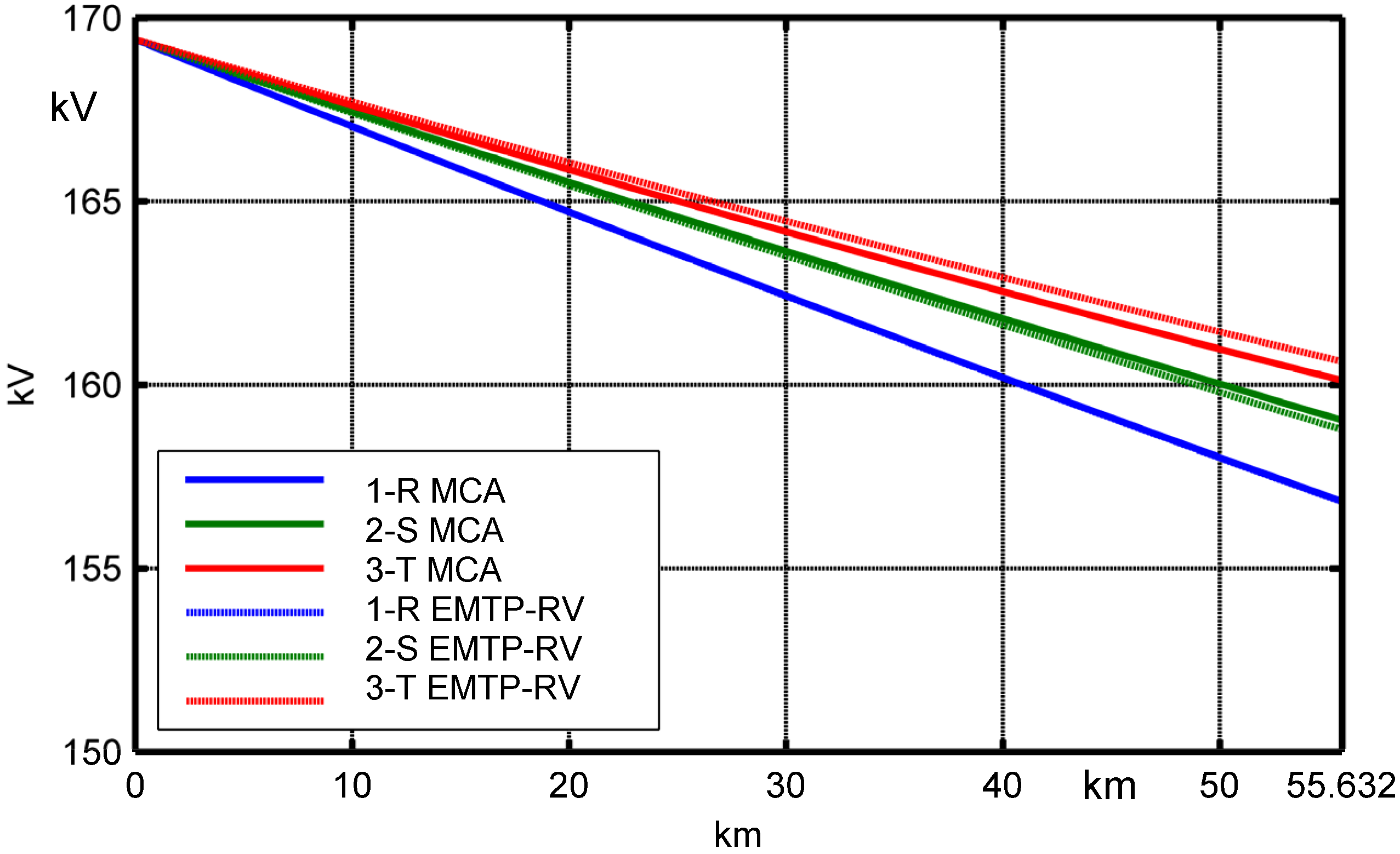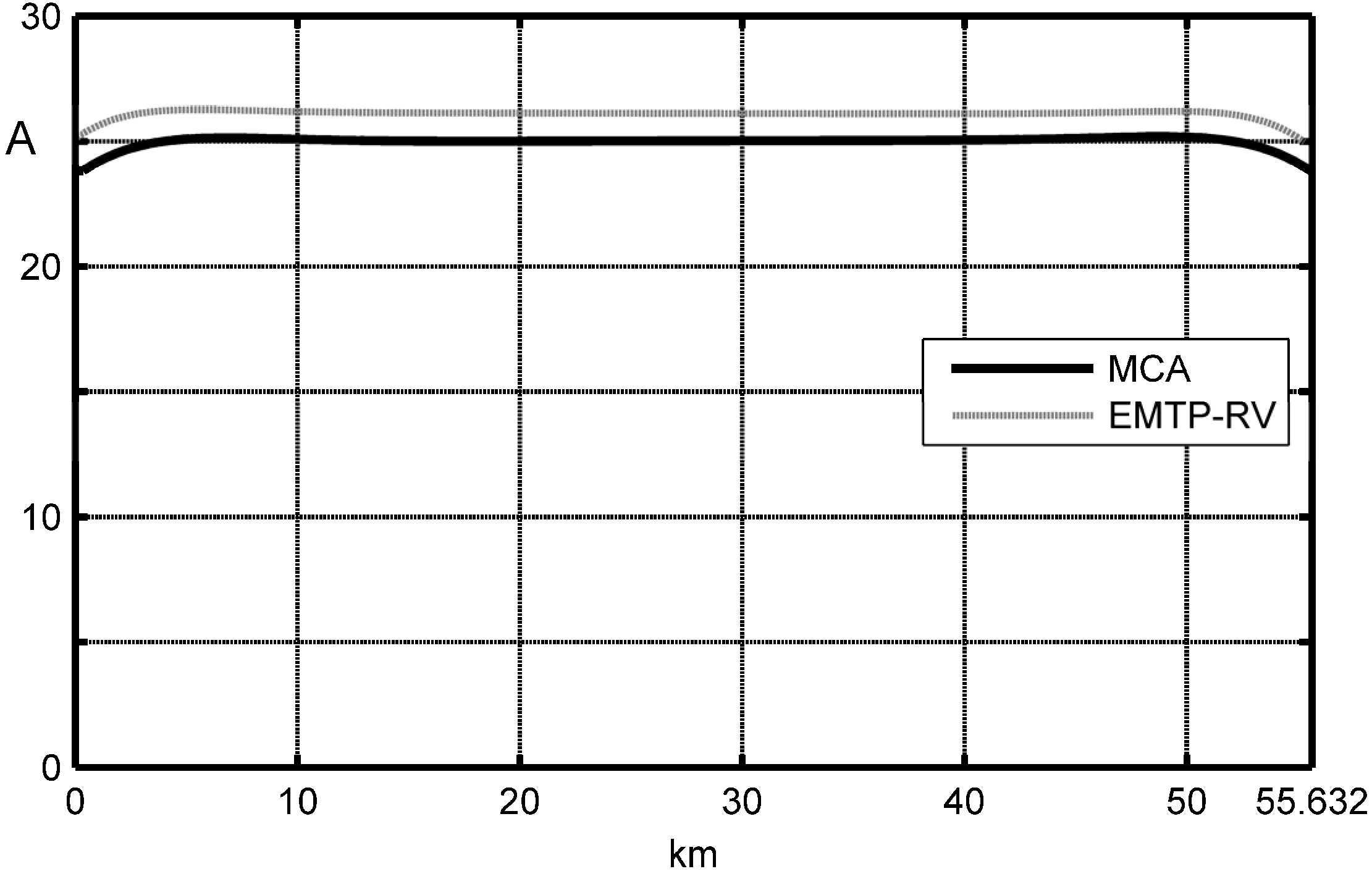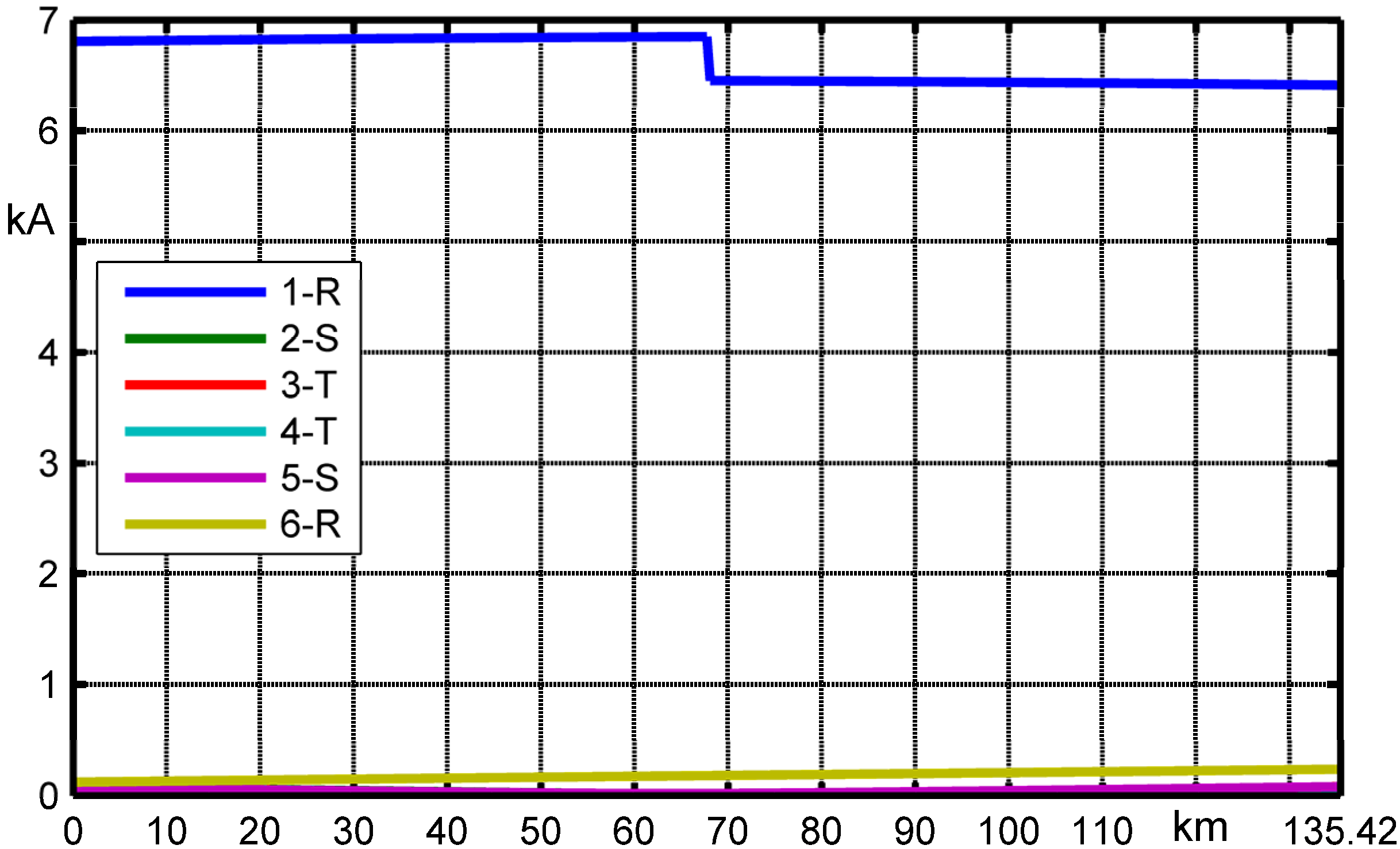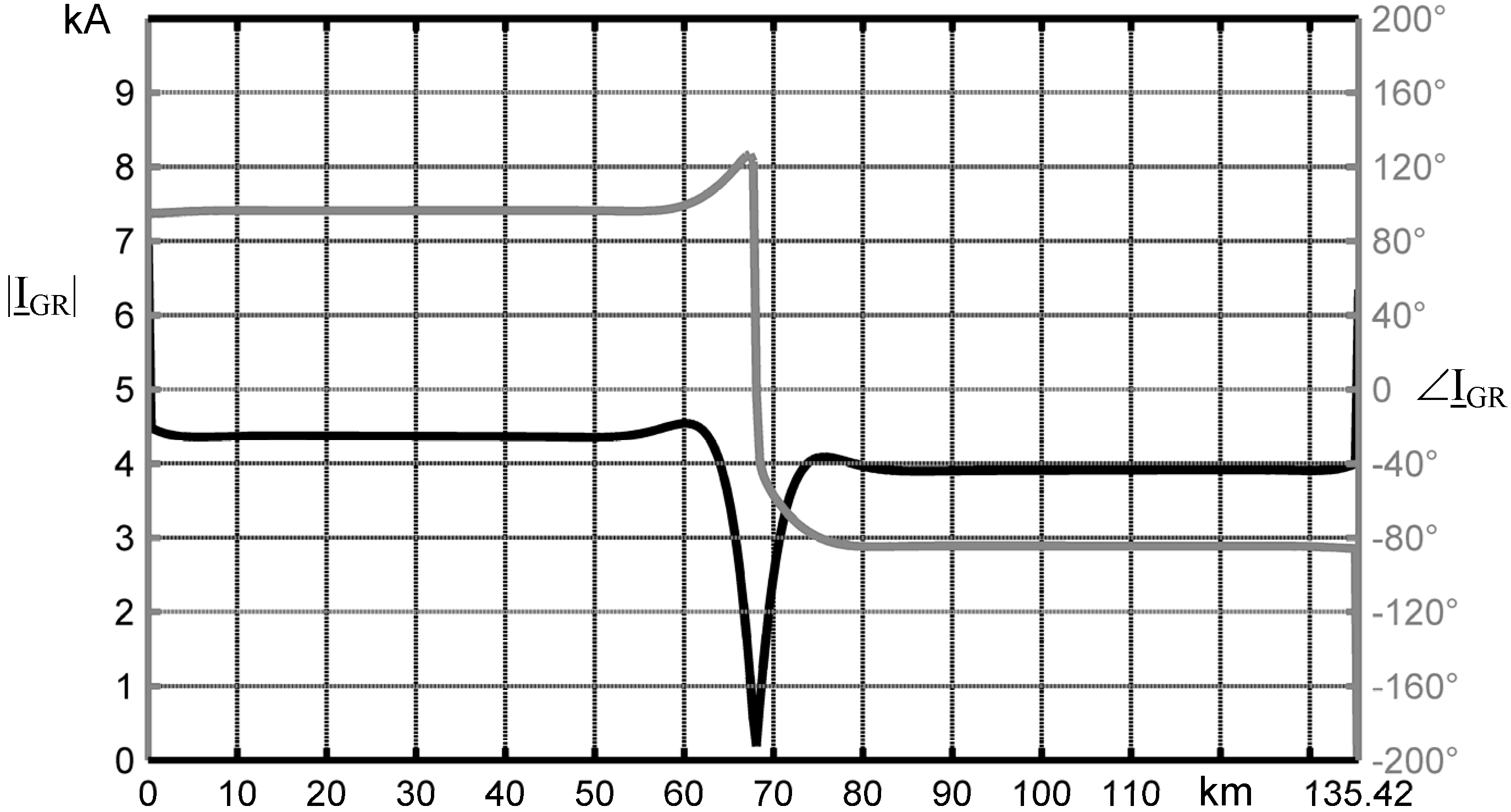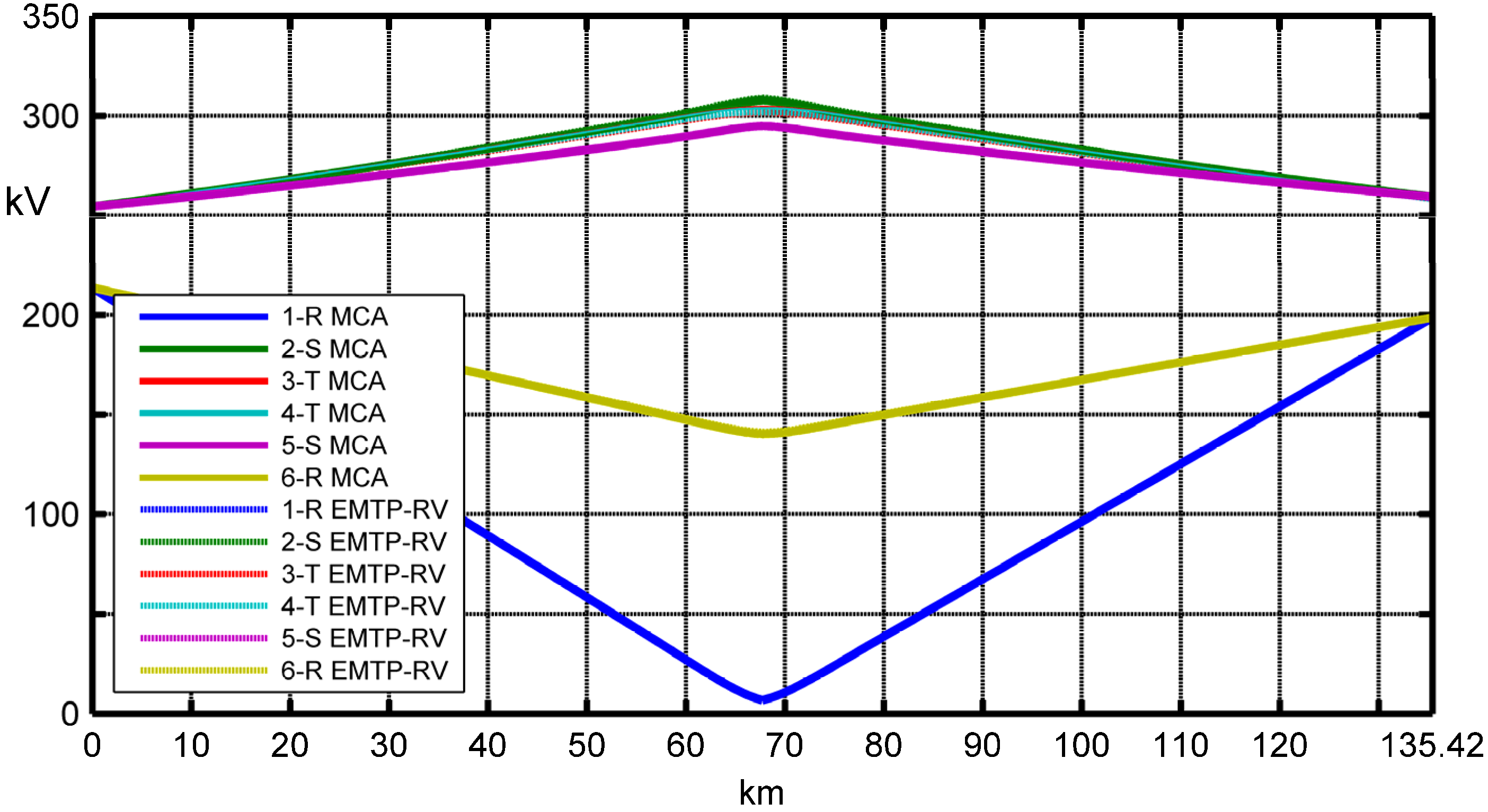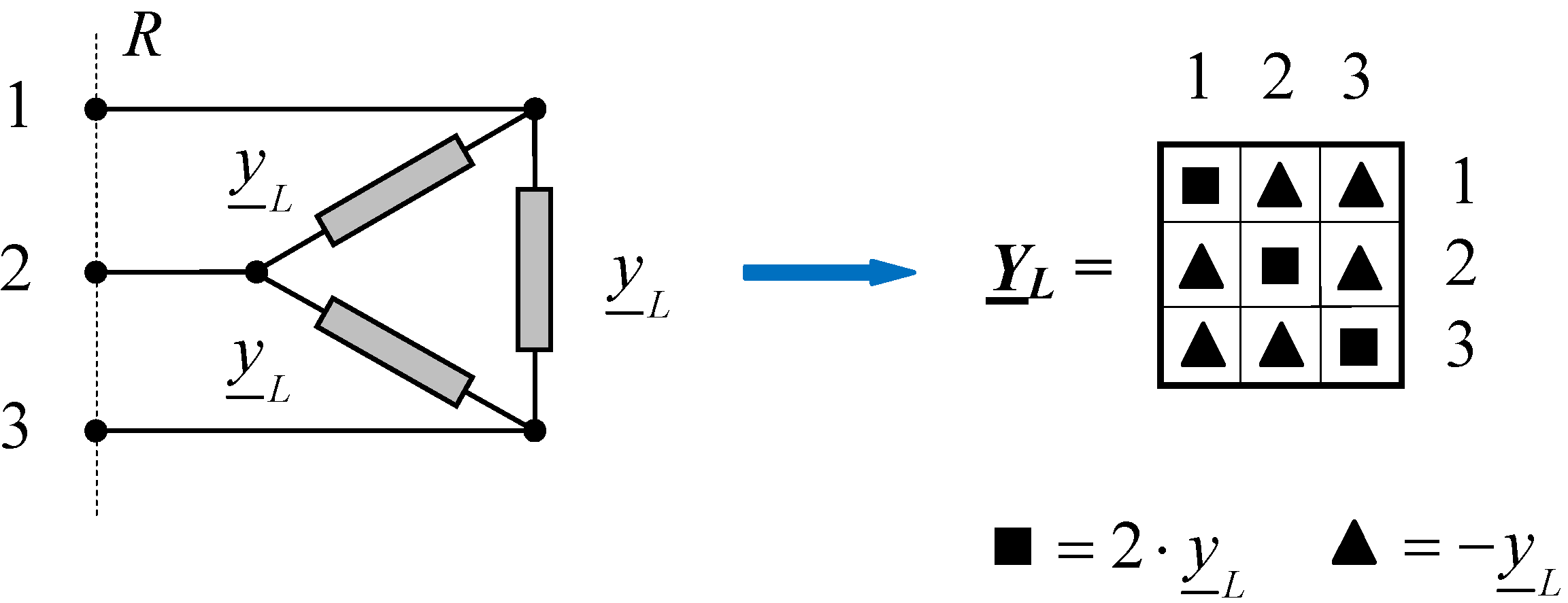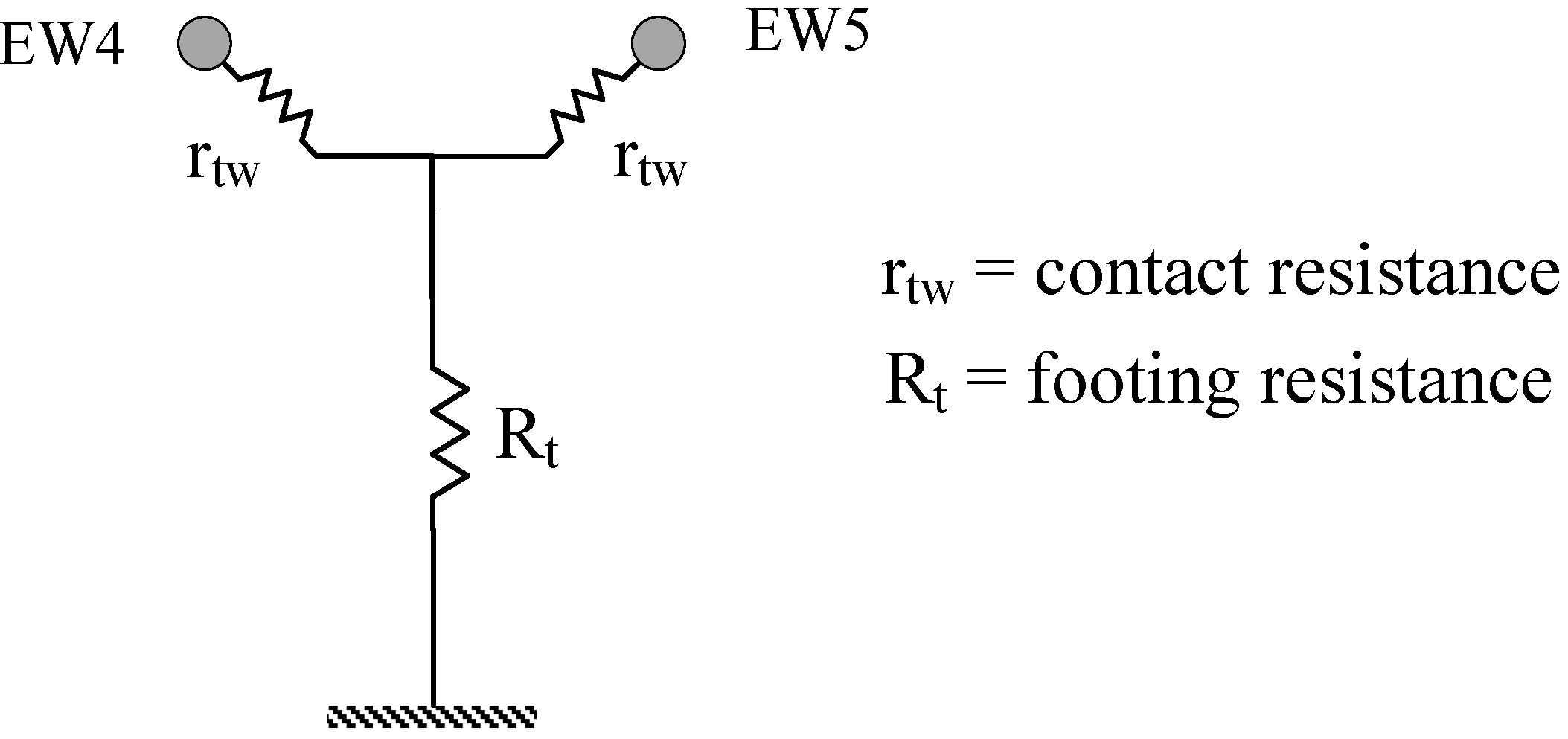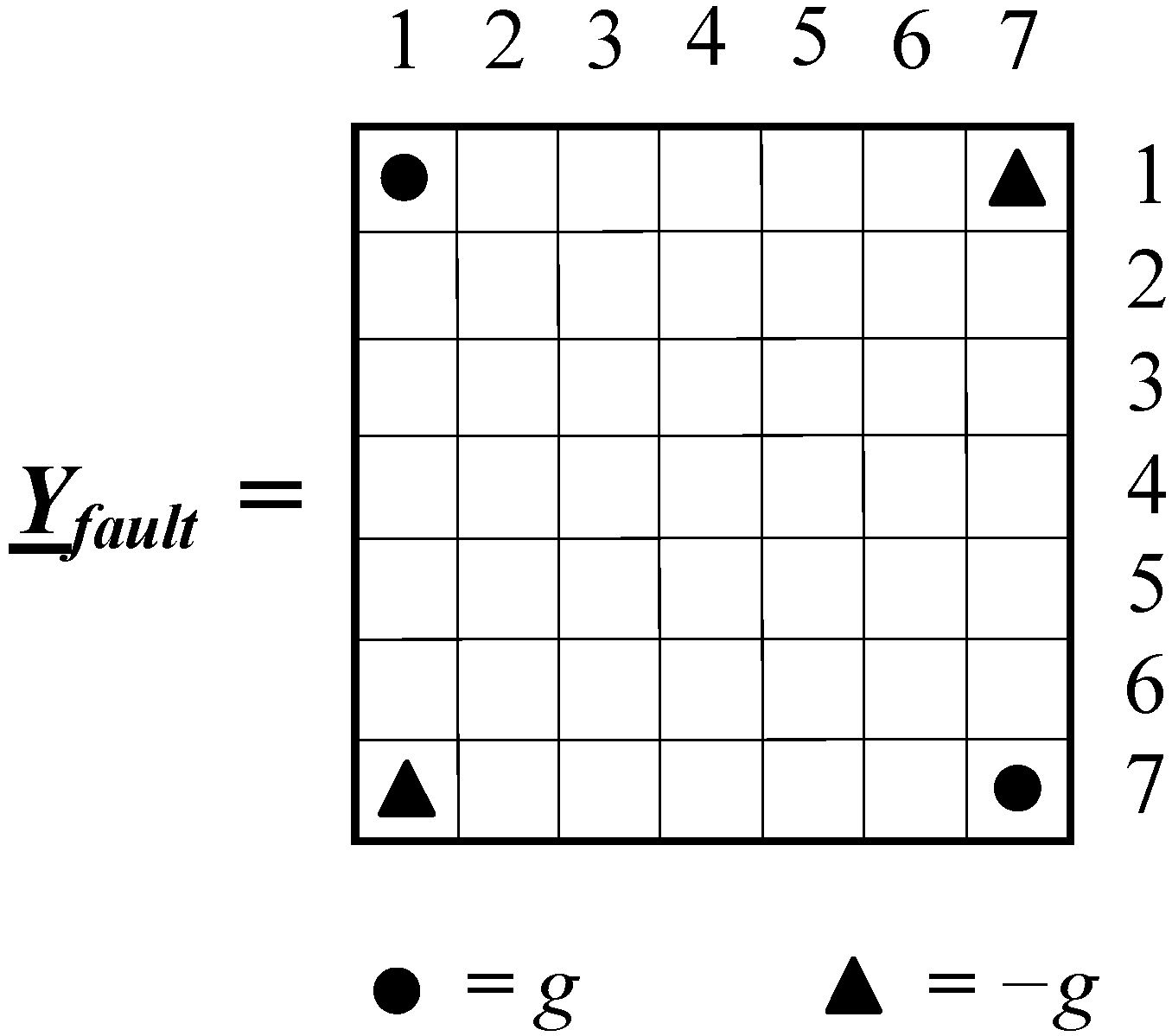2. Application of MCA to Overhead Lines
MCA has been already applied to a great number of asymmetrical systems: cross-bonded underground insulated cables [
1,
2], shunt compensated ones, distribution line carrier, solid bonded or multiple-point bonded gas insulated lines [
3], Milliken type EHV insulated cables. In this paper a thorough exposition of the application of MCA to overhead lines is presented. It allows considering:
- (1)
Single or double circuit in electrical parallel with any type of phasing (low reactance or super bundle ones);
- (2)
Any tower type, with different earth resistivities along the line and different tower resistances;
- (3)
The steady-state regime of an OHL supplying a balanced (or not) three-phase load;
- (4)
Faulty regimes (line-to-earth, line-to-line, line-to-line-to-earth, three phase short-circuit), with two end substations each characterized by its own fault levels.
For the sake of a clear explanation, let us consider a single-circuit OHL composed of five conductors (
n = 5; see
Figure 1) parallel to themselves and to the ground: 1, 2, 3 are the phase conductors (in
Figure 1, bundle ones) and 4, 5 are the earth wires.
Figure 1.
Multiconductor representation of OHL supplying a static balanced load; SEND—sending-end; REC—receiving-end.
Figure 1.
Multiconductor representation of OHL supplying a static balanced load; SEND—sending-end; REC—receiving-end.
This multiconductor line may be represented as a cascade of
N elementary cells of length Δ (e.g., Δ = span length), modelled by a lumped π circuit (see
Figure 2).
Figure 2.
Cascade of N elementary cells for OHL modelling.
Figure 2.
Cascade of N elementary cells for OHL modelling.
Being Δ sufficiently small, it is possible to lump distributed shunt admittances at the ends of the cell (
YTS and
YTR are the transverse blocks), thus allowing the separate study of longitudinal elements. In order to form
ZL, it is necessary to compute the self and mutual longitudinal impedances, which account for the earth return currents. They can be obtained by applying the simplified Carson-Clem formulae [
4] or the complete Carson formulae [
5] with Carson’s corrections in terms of series [
6]. It has been widely demonstrated by one of the authors that at power frequency (50 or 60 Hz) the Carson-Clem formulae are very precise and consequently they are a powerful tool so giving the same results of complete Carson ones (
Section 5).
In order to give the above mentioned sentence a theoretical justification, the simplified Carson-Clem formulae can be licitly applied if the spacing between conductors
di,j ≤ 0.135
De when
[m] “Carson Depth”;
ρ = electrical resistivity of the soil [Ωm];
f = power frequency (50–60 Hz). By supposing
f = 50 Hz and a low earth resistivity e.g., 10 Ωm, it yields:
The spacings between phases in OHL are never greater than 40 m, therefore it is rather unlikely to have the condition
di,j > 0.135
De 40 m even with very low resistive earth; hence the Carson-Clem formulae can be always used. With great mutual spacings between phases belonging to different circuits in the same corridor, the complete Carson formulae must be used. The self and mutual impedances by means of Carson-Clem formulae are given by:
where
ri = kilometric resistance of conductor
i [Ω/km] (if bundle conductor with
n subconductors per phase
);
di′ = 2·GMR =
k″d [m] (GMR = Geometrical Mean Radius) where
k′′ are listed in tables depending upon the composition of the conductor and
d [m] is the diameter of the conductor (if bundle conductor:
where
Rcircle [m] is the radius of the circle on which the subconductors lay and
dsub [m] is the diameter of the subconductors);
di,j = distance between conductor
i and
j [m]. Once
zi,i and
zi,j have been computed, it is possible to form the matrix
ZL (5 × 5) and to characterize, by means of Equation (4) the steady state regime of longitudinal block
L of
Figure 2 (where all voltage and current vectors are shown):
and by considering the evident relation Equation (5):
it yields:
The Equations (6,7) can be written in an elegant matrix form as:
The matrix YLΔ (10 × 10) is the admittance matrix regarding block L circuit formed by five longitudinal links.
The shunt capacitive matrix computation can be obtained from Maxwell potential coefficient matrix. Its elements are easy to compute from the tower geometry and from the conductor radii [
7]. It is worth remembering that the average heights of conductors can be used by means of Equation (9):
where
htower is the conductor height at tower.
Then, as already mentioned, the shunt capacitive and conductive links are divided into two halves and lumped at the ends of the elementary cell. The capacitive susceptances (of half cell) between each conductor are considered in the (5 × 5) matrix
YTS =
YTR. The vectors of the shunt currents at both ends of the cell are (see
Figure 2):
Hence the steady state regime of the elementary cell is represented by
YΔ which is the superimposition of
YLΔ and
YTΔ:
2.1. Steady State Regime of Single Circuit EHV OHL
In order to achieve a complete analysis of an overhead line it is necessary to obtain the admittance matrix
Y of the whole multiconductor system shown in
Figure 3 (where S
g, S
0,…. S
L indicate the sections or ports). This involves all the elements of the line which can be represented by their admittance matrix: (by starting from the left side) the equivalent supply network matrix
Ypha (3 × 3) (see
Appendix I), the load matrix
YL (3 × 3) (see
Appendix II), the tower matrix
YTW (2 × 2) (see
Appendix III), and, of course, the already mentioned elementary cell matrices
YΔi. In short-circuit occurrence (
Section 4), the equivalent substation impedance
YSUB (3 × 3) and fault matrix
Yfault (see
Appendix IV) must be considered.
On the basis of the equation which leads to the general formulation of the current vectors injected in the different ports of the system (S
g, S
0,…. S
L), it can be ascertained that the admittance matrix
Y is formed by partial overlapping ("tile style") of the above mentioned matrices as shown in
Figure 3b. The resulting admittance matrix
Y can be of large dimensions (depending upon the ratio OHL length/Δ
l) but it can be easily managed because of it is structurally sparse. Anyway, the use of the admittance frame of reference allows introducing easily local modifications of the system structure without reconstructing its entire matrix.
Figure 3.
(a) Single circuit overhead line; (b) Structure of the matrix Y.
Figure 3.
(a) Single circuit overhead line; (b) Structure of the matrix Y.
If the modification is between two sections, it is sufficient to substitute the matrix representing the modification for that existing before. If the modification is derived from a section, the matrix representing the modification must be superimposed in that section (e.g. the tower presence anywhere along the OHL). In fact, they can be represented by their admittance matrices which must be superimposed in the right location of matrix Y so to give a new total matrix YTOT.
2.2. Steady State Matrix Solution of Multiconductor System
For the system of
Figure 3b, the general equation
i = YTOT u can be partitioned as in
Figure 4. It is worth noting that only
ipha is a non zero current vector whereas
ix ≡ 0 so that it yields:
and thus:
where
Y4 is not singular and
upha is fixed. So by knowing the subvector
ux the steady state regime of any cell, and hence of the whole multiconductor system, is completely available without iterations.
Figure 4.
Partitioned matrix of i = YTOTu.
Figure 4.
Partitioned matrix of i = YTOTu.
The inversion of
Y4 in Equation (13) could give computational drawbacks, but even if
Y4 is of great dimensions (
i.e., with great number of
N cells), its inversion can benefit from the partition in submatrices [
8] and the use of parallel computing.
3. Application to HV OHL on Steady State Regime
The proposed multiconductor algorithms are applied to a 275 kV 2 × 400 mm
2 single circuit aluminum conductor steel reinforced (ACSR) OHL (
Figure 5), whose geometrical and electrical characteristics are reported in
Table 1.
Figure 5.
Single circuit OHL tower arrangement.
Figure 5.
Single circuit OHL tower arrangement.
Table 1.
OHL geometrical and electrical characteristics.
Table 1.
OHL geometrical and electrical characteristics.
| Overhead line | Symbol | Unit | Value |
|---|
| Voltage level | - | kV | 275 |
| Line length | - | km | 55.632 |
| Span length | - | km | 0.366 |
| Earth resistivity (assumed equal along the line) | - | Ω m | 100 |
| Symmetrical loading at receiving end | - | MW + j Mvar | 508.8 + j 103.32 |
| Substation earthing resistance | - | Ω | 0.1 |
| Tower earthing resistance (assumed equal for all the tower) | - | Ω | 10 |
| Conductor diameter (bundle conductor) | - | mm | 2 sub-cond. ACSR Lynx Ф = 19.53 mm |
| Per unit length resistance at 75° operation (50 Hz) | R | mΩ/km | 96.10 |
| Per unit length series inductance | l | mH/km | 1.1051 |
| Per unit length shunt leakance (50 Hz) | gav | nS/km | 44.5 |
| Per unit length capacitance | c | μF/km | 0.010215 |
| Ampacity referred to winter rating [9] | Ia | A | 545 × 2 |
| Winter rating [9] | - | MVA | 519.2 |
By means of the procedures of
Section 2.2 it is possible to completely know the steady state behaviors of the electrical quantities along the line.
Figure 6 shows the phase voltage behaviors along the line. There is a voltage drop which is different from phase to phase due to the asymmetrical nature of the un-transposed OHL.
Figure 6.
Line-to-earth voltage magnitudes along the OHL.
Figure 6.
Line-to-earth voltage magnitudes along the OHL.
The phase current magnitudes are almost constant along the line (
1090 A) (see
Figure 7) due to the very low capacitive susceptance of OHL. The earth wire voltage along the line is almost null (see
Figure 8). This is a confirmation that it is licit to use the elimination technique of grounded conductors.
It is meaningful to observe that, even in steady state regime, both the induced currents in the earth wires and the ground return current are not negligible. The earth wire induced current magnitudes along the line have an almost constant value of 96 A (see
Figure 9).
Figure 7.
Phase current magnitudes along the OHL.
Figure 7.
Phase current magnitudes along the OHL.
Figure 8.
Earth wire voltage magnitudes along the OHL.
Figure 8.
Earth wire voltage magnitudes along the OHL.
Figure 9.
Earth wire current magnitudes (left axis) and angles (right axis) along the OHL.
Figure 9.
Earth wire current magnitudes (left axis) and angles (right axis) along the OHL.
One of the most important features of MCA is that it allows directly achieving the ground return current. Since MCA can compute all the conductor current phasors in each section,
IGR is given by the 1st Kirchhoff’s Law:
With the constant loading of
Table 1 (
S = 508.8 MW +
j103.32 MVar), |
IGR |= 25 A (see
Figure 10). This current could be responsible for ac metallic corrosion [
10] and induced voltages on parallel metallic pipes buried in the neighborhood of OHL.
Figure 10.
Ground return current magnitude and angle along the OHL.
Figure 10.
Ground return current magnitude and angle along the OHL.
Another important result from MCA is the possibility to compute the whole power losses which are 19.269 MW. In order to roughly validate this value, it is possible to consider a constant current in the phase conductor equal to 1090 A so that the three-phase power losses result:
To these phase conductor power losses, the insulator and corona losses must be added so that it has:
The power losses in the earth wires are not negligible and can be computed (by considering that the induced currents are 96 A constant along the line as in
Figure 9) by means of:
The whole power losses are given by the sum of the three abovementioned components
i.e.:
which is in very good agreement with the power losses computed by MCA.
Comparison between the MCA and EMTP-RV
In this section some of the above presented MCA results are compared with the EMTP-RV results for the OHL of
Section 3. The EMTP-RV electrical layout (the first and the last of four pages) is shown in
Figure 11.
Figure 11.
EMTP-RV single circuit OHL electrical layout (pages 1/4 and 4/4).
Figure 11.
EMTP-RV single circuit OHL electrical layout (pages 1/4 and 4/4).
Figure 12 shows the phase voltage magnitude behavior along the single circuit OHL by means of MCA and EMTP-RV. The per cent voltage drops are reported in
Table 2 where it infers that the maximum difference between the MCA and EMTP-RV is equal to 5.28%. The cpu-time in the simulation with MCA is 0.2087 s and with EMTP-RV is 0.3125 s (INTEL CORE 2 QUAD
[email protected] GHz, 3.25 GB RAM).
Figure 12.
Voltage magnitude comparison between MCA and EMTP-RV along the OHL.
Figure 12.
Voltage magnitude comparison between MCA and EMTP-RV along the OHL.
Table 2.
Single circuit OHL voltage drop comparison.
Table 2.
Single circuit OHL voltage drop comparison.
| Eliminate | Voltage drop [%] |
|---|
| Phase 1-R | Phase 2-S | Phase 3-T |
|---|
| MCA | 7.4% | 6.1% | 5.49% |
| EMTP-RV | 7.4% | 6.26% | 5.2% |
| Percentage difference | 0.0% | 2.62% | 5.28% |
In
Table 2 “percentage difference” means:
In
Figure 13 the steady state |
IGR| for OHL of
Section 3 is shown by using the MCA and EMTP-RV results. The maximum current difference is 1 A (4%).
Figure 13.
Steady state ground return current magnitude comparison between the MCA and EMTP-RV.
Figure 13.
Steady state ground return current magnitude comparison between the MCA and EMTP-RV.
4. Short-Circuit Analysis of Double-Circuit Overhead Line 400kV
In this section a double circuit OHL 400 kV 2 × 400 mm
2 ACSR, whose electrical and geometrical characteristics are reported in
Table 3, has been studied on faulty regime by means of MCA (see Appendix IV). The tower arrangement is reported in
Figure 14.
Table 3.
Data assumed in the MCA for double-circuit OHL.
Table 3.
Data assumed in the MCA for double-circuit OHL.
| Overhead line | Symbol | Unit | Value |
|---|
| Voltage level | - | kV | 400 |
| Line length | - | km | 135.42 |
| Span length | - | km | 0.366 |
| Earth resistivity (assumed equal along the line) | - | Ω m | 100 |
| Symmetrical loading at receiving end | - | MW + j Mvar | 2 × (2172.7 + j 441.2) |
| Substation earthing resistance | - | Ω | 0.1 |
| Tower earthing resistance(equal for all the towers) | - | Ω | 10 |
| Conductor diameter (bundle conductor) | - | mm2 | 4 sub-cond. ACSR Zebra Ф = 28.62 mm |
| Per unit length resistance at 25° (50 Hz) | r | mΩ/km | 8.25 |
| Per unit length series inductance | l | mH/km | 0.4218 |
| Per unit length shunt leakance (50 Hz) | gav | nS/km | 33.56 |
| Per unit length capacitance | c | μF/km | 0.0266521 |
| Ampacity referred to winter rating [11] | Ia | A | 800 × 4 |
| Winter rating [11] of double-circuit | MVA | - | 2 × 2217 |
Figure 14.
Tower characteristics of 400 kV double-circuit OHL in electric parallel with low reactance phasing.
Figure 14.
Tower characteristics of 400 kV double-circuit OHL in electric parallel with low reactance phasing.
Let us suppose the fault occurring at midline (
i.e., at 67.71 km from both ends) between one phase (e.g., 1R phase) and earth wire (line-to-earth short-circuit). It is worth remembering that in order to characterize the end substations it is necessary to know the fault levels (three-phase x
1, x
2 and single-phase y
1, y
2 sub-transient short circuit currents usually given by TSO) as in
Figure 15.
Figure 15.
Multiconductor line in short-circuit condition supplied by end substations.
Figure 15.
Multiconductor line in short-circuit condition supplied by end substations.
Once the fault levels are known, the equivalent sequence impedances and phase impedances of each substation can be computed by means of the procedure in Appendix I, in order to create the equivalent supply network matrix. The short-circuit between a phase and the earth wire can be considered by means of the matrix
Yfault reported in Appendix IV. In accordance with IEC 60909-0 [
12], a voltage factor must be applied to the nominal line-to-earth voltage. Since maximum currents in HV and EHV installations are considered, the voltage factor is 1.1. With regard to the resistances of the conductors, IEC-60909-0 states that, when computing the maximum currents, they have to be computed at 20 °C (cold conductors). Let us suppose the fault levels (for computation of equivalent sequence and phase impedances see Appendix IV) of
Table 4. In the same table the equivalent sequence impedances have been reported.
Table 4.
Data assumed in the MCA for fault levels.
Table 4.
Data assumed in the MCA for fault levels.
| Substation | Fault levels and equivalent sequence impedances |
|---|
| SEND. | |
| REC. | |
Figure 16 shows the phase voltage magnitudes along the OHL. At midline the phase 1-R voltage magnitude is equal to the tower voltages (which is the same voltage of the earth wire). Also the phase 6-R of healthy circuit has a voltage drop whereas all the other phase voltage magnitudes have an overvoltage. These ones are the so called “temporary overvoltages due to earth faults” or power frequency overvoltages of relatively long duration.
Figure 17 shows the current sharing between the six phases: 6.85 kA coming from substation SEND. and 6.45 kA from substation REC. due to the different fault levels. The fault current |
I1P-1R| is equal to 13.304 kA whereas healthy phases (or un-faulted phases) have almost zero current. Beyond the faulted phase 1-R, the only not-negligible short circuit current flows in the phase which is in parallel with 1-R
i.e., 6-R (since “low reactance” phasing has been applied). The short circuit currents in all the other phases are almost zero since, according to IEC 60909-0, the shunt load admittance can be neglected so that the faulted network is at no-load.
Figure 16.
Line-to-earth voltage magnitudes along the line.
Figure 16.
Line-to-earth voltage magnitudes along the line.
Figure 17.
Phase current magnitudes along the line.
Figure 17.
Phase current magnitudes along the line.
The earth wire current magnitude |
IEW| (see
Figure 18) decreases from the fault location up to a given number of spans injecting current into the earth. This number of spans, after which there is not current injection into the earth anymore, can be theoretically evaluated [
7,
13]. By observing
Figure 18 it can be ascertained that after 8 km from the fault location the earth wire stops injecting current into the earth.
Figure 19 shows the ground return current magnitudes and the angles for a midline short-circuit along the line.
It is worth noting that the exact knowledge of the ground return current behaviour results fundamental when evaluations of EMI must be assessed in a given point along the line so that the only knowledge of the sending and receiving end values |IGR| are not enough.
Figure 18.
Earth wire current magnitude |IEW| along the line in fault condition.
Figure 18.
Earth wire current magnitude |IEW| along the line in fault condition.
Figure 19.
Ground return current magnitude |IGR| and angle along the line in fault condition.
Figure 19.
Ground return current magnitude |IGR| and angle along the line in fault condition.
Comparison with EMTP-RV
Some of the above presented MCA results are compared with the EMTP-RV ones for the OHL of previous section whose EMTP-RV electrical layout is shown in
Figure 20.
Figure 20.
EMTP-RV double-circuit OHL electrical layout (pages 1/6 and 6/6).
Figure 20.
EMTP-RV double-circuit OHL electrical layout (pages 1/6 and 6/6).
Figure 21 shows the phase voltage magnitude behaviors along the double circuit OHL by means of MCA and EMTP-RV. The maximum percentage voltages for each phase are reported in
Table 5 where the maximum value is equal to 0.95%. The cpu-time in the simulation with MCA is 3.41 s and with EMTP-RV is 3.5 s (INTEL CORE 2 QUAD
[email protected] GHz, 3.25 GB RAM). |
IGR| comparison is shown in
Figure 22. The maximum difference between the MCA and EMTP-RV ground current magnitude is 77 A (−1.9%). In conclusion, the agreement between MCA and EMTP-RV is extremely good.
Figure 21.
Line-to-earth voltage magnitude comparison between the MCA and EMTP-RV under phase-to-earth short circuit in a double-circuit OHL.
Figure 21.
Line-to-earth voltage magnitude comparison between the MCA and EMTP-RV under phase-to-earth short circuit in a double-circuit OHL.
Table 5.
Double-circuit line maximum voltage magnitude comparison.
Table 5.
Double-circuit line maximum voltage magnitude comparison.
| Eliminate | Max. faulted circuit voltage magnitudes [kV] | Max. healthy circuit voltage magnitudes [kV] |
|---|
| Phase 1-R (faulted phase) | Phase 2-S | Phase 3-T | Phase 6-R | Phase 5-S | Phase 4-T |
|---|
| MCA | 6,68 | 307,7 | 304,6 | 140,4 | 294,8 | 303,8 |
| EMTP-RV | 6,74 | 308,8 | 301,7 | 141,4 | 295,3 | 301,9 |
| Percentage difference | −0.9% | −0.36% | 0.95% | −0.71% | 0.16% | 0.62% |
Figure 22.
Ground return current comparison between the MCA and EMTP-RV under line-to-earth short circuit in a double-circuit OHL.
Figure 22.
Ground return current comparison between the MCA and EMTP-RV under line-to-earth short circuit in a double-circuit OHL.
